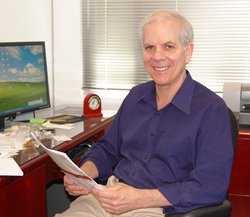The Life of a Red Blood Cell
By Billie Rubin
Red blood cells are born in the bone marrow of our large bones at a rate of 2 million every second! Our bone marrow is a heavy-duty erythropoietic ward.
By Billie Rubin
Red blood cells are born in the bone marrow of our large bones at a rate of 2 million every second! Our bone marrow is a heavy-duty erythropoietic ward.
By Julie Ruel, Social Media Manager, Stanford Blood Center

Cytomegalovirus (CMV) is not an unfamiliar term in the blood banking world. A member of the herpes family, it is one of the many tests we perform on each unit of donated blood. For healthy individuals, having the virus, or what we refer to as being CMV positive, isn't harmful. And if healthy, unless you've specifically been tested for CMV, you most likely don't know whether you have the antibody to it or not. However, for infants or those with impaired immune systems, it can be deadly. Because of this, Stanford Blood Center routinely tests for it and was in fact, the first blood center in the world to provide CMV negative blood to hospitals for immunocompromised transfusion recipients.

On Dec. 29, 2010, Linda Johnson became the first woman to make 500 donations at Stanford Blood Center. It was more than 20 years ago when Linda's friend and Stanford Blood Center platelet donor, Stan Jensen, urged her to check if she would make a good platelet donor. Linda was a perfect candidate with good veins and a high platelet count.
By Ed Engleman, MD, Founder and Medical Director, Stanford Blood Center

During the early 1980s we decided to apply new research technology to a clinical problem: the prevention of the transmission by transfusion of Acquired Immune Deficiency Syndrome (AIDS). The problem was highly charged with social, political, legal, ethical, and economic overtones complicating the technical and medical issues at hand. In a decision that engendered intense controversy, in 1983 Stanford Blood Center instituted the first blood testing program specifically intended to reduce the risk of transfusion transmission of the then uncharacterized, but presumed infectious cause of AIDS.
By Geoff Belanger, Donor Services Document & Project Manager

I've worked at the Blood Center for a little over seven years now in a variety of roles, beginning as a phlebotomist. If you've donated on a mobile between 2004 and 2008, there is a good chance I drew your blood, some more than a few times.

By Phillip King, long-time Stanford Blood Center platelet donor Above, Phillip is donating platelets after being the very first donor to try out our new software system for the registration process. Today’s entry is one of those gimmicky pieces...
By Julie Ruel, Social Media Manager, Stanford Blood Center

One common question we hear from blood donors is, "Why do I need to answer the same questions each time I come in to give blood? Can't you keep my responses on file?" We cannot and here's why. The Food and Drug Administration (FDA) requires that all blood centers ask all blood donors all questions on the day of each blood donation as a safety measure. Honesty and consistency in answering these questions is critical. The safety of the blood supply and the patients receiving the blood depend on truthful answers.
By Ruthann Richter, Director of Media Relations at the Stanford School of Medicine.
One of the many controversies I covered was the decision by the Stanford Blood Center to be the first in the country to test for the virus in donated blood. The move was reviled in the blood banking industry, for it called into question the safety and reliability of the nation's blood supply. The blood center later would be vindicated, as every other bank would ultimately follow suit and routinely test for HIV. Center Director Ed Engleman, MD, says Stanford's early initiative saved some 30,000 lives.
By Billie Rubin
Guess who regulates how many red blood cells (RBCs) we need at any given time. Bone marrow? Liver? Spleen? Your lungs? Give up? It's your kidneys. Yup, they don't just make urine. It all starts when those little kidneys sense the level of oxygen in our blood. When the oxygen level is low, the kidneys put out a hormone called erythropoietin.
At our May 2011 Café Scientifique, Dr. Dement discussed the importance of sleep and the consequences of sleep deprivation, narrowing in on three major sleep disorders; insomnia, narcolepsy and obstructive sleep apnea (OSA) and best treatment practices. He also shared his personal challenges with insomnia. Click here to listen to the podcast from his talk.